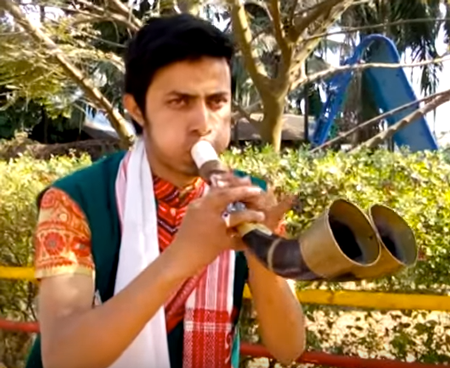(a.k.a. Pempa, Xuri, Singra or Pepati)

The pepa (a.k.a pempa, xuri, singra, or pepati) is a reed hornpipe that is found in Assam.
The pepa has a great antiquity. It appears that it was first introduced by buffalo herders. An old legend has it that once upon a time, the horn of a dead buffalo was laying on the banks of the Brahmaputra river. It seems that a breeze excited the horn such that it started to spontaneously make a sound. This piqued the interest of a local buffalo herder who investigated it, and was then inspired to build the first pepa.
There are two versions of the pepa. Some are single while some are double. It is constructed of a small body of one or two lengths of reed or bamboo, to which are attached one or two horns of a buffalo. If it is of a single horn/bamboo type, five or six holes may be seen. If it is a dual body, then generally each length of bamboo has 4 holes. Increasingly bamboo or wood is being incorporated as a substitute for the buffalo horns. Frequently a metal ring is attached to the opening of the horn; this is both for decoration as well as mechanical reinforcement. The size of the pepa is variable, but generally they are just under 2 feet in length.
The pepa is very much associated with the Bohag Bihu festival (a.k.a Rongali Bihu) which comes in April. This festival is associated with the rice harvest, and is regarded as the start of the Assamese new year.
| THESE BOOKS MAY NOT BE FOR YOU |
|---|
A superficial exposure to music is acceptable to most people; but there is an elite for whom this is not enough. If you have attained certain social and intellectual level, Elementary North Indian Vocal (Vol 1-2) may be for you. This has compositions, theory, history, and other topics. All exercises and compositions have audio material which may be streamed over the internet for free. It is available in a variety of formats to accommodate every budget. Are you really ready to step up to the next level? Check your local Amazon. |